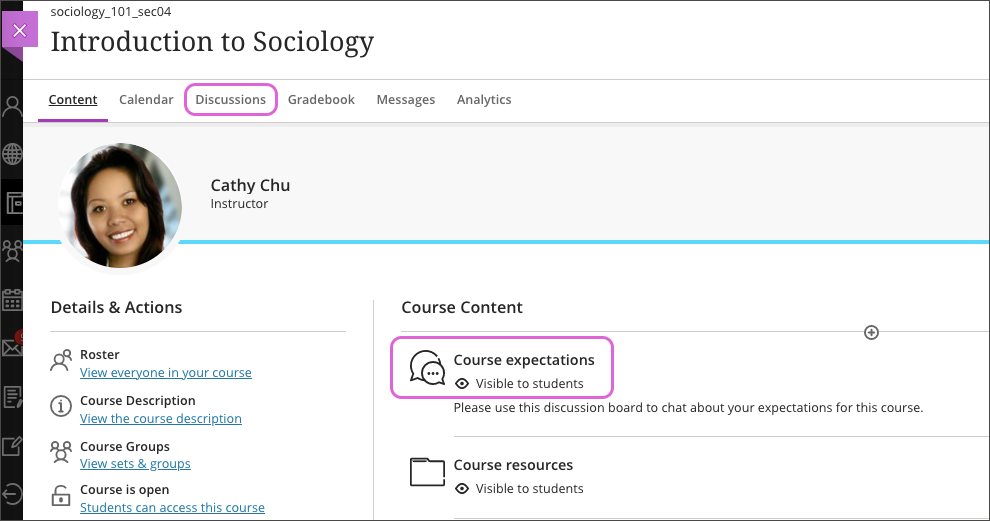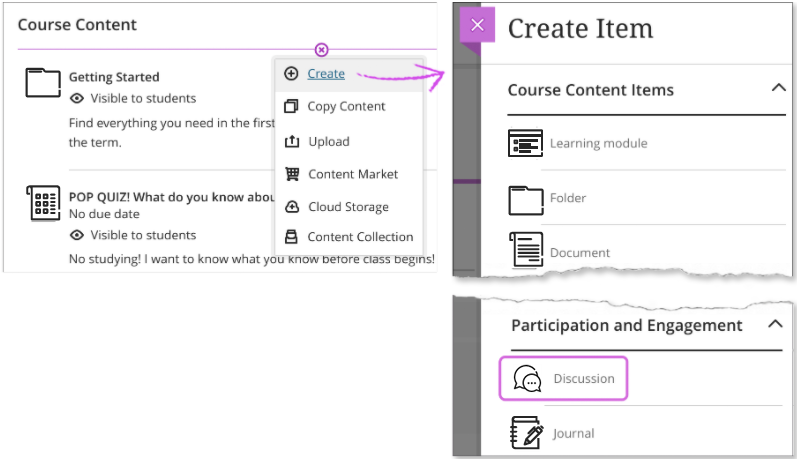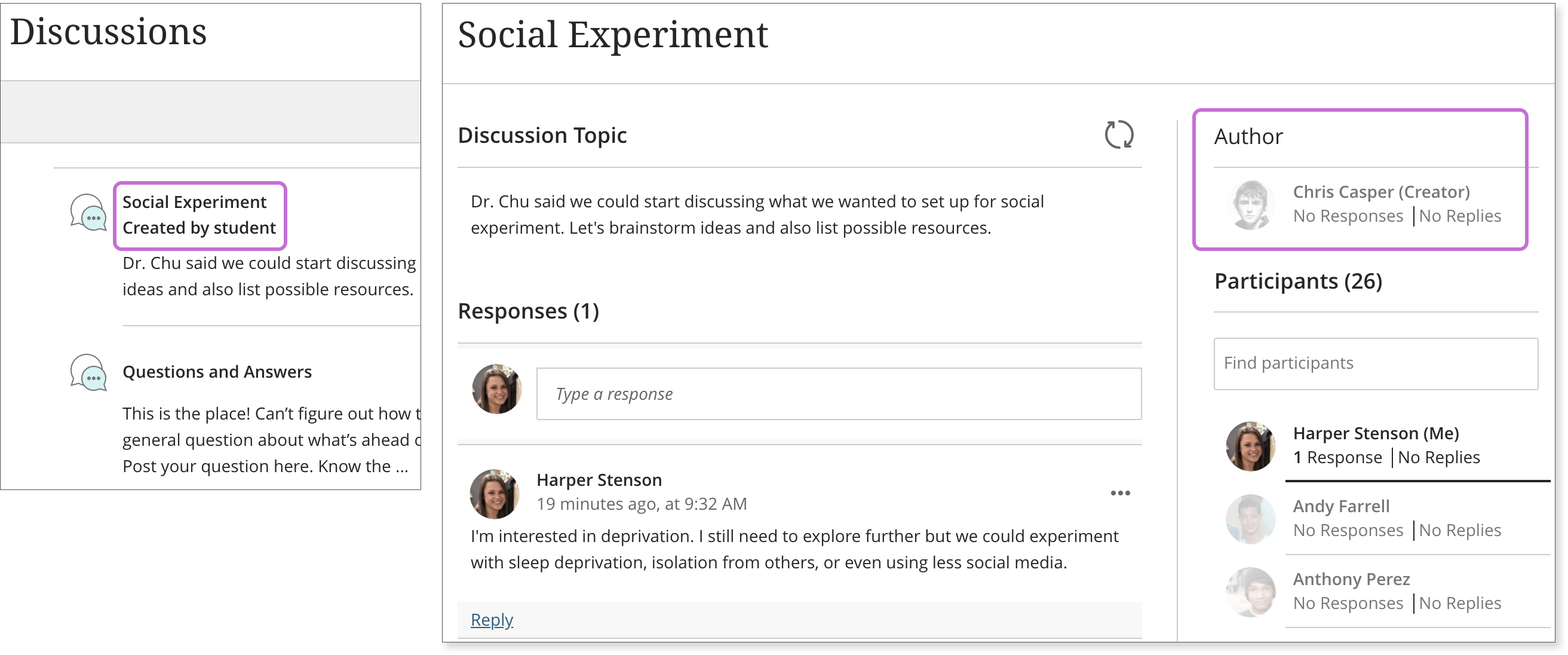How To Create A Discussion Forum In Blackboard
Open the line of communication and engage your students with online discussions.
Discussions are a good way to encourage students to think critically about their coursework and interact with each others' ideas. You can create discussions around individual course lessons or for your course in general. As the instructor, you own the discussions. After you start a discussion, you can post comments of your own to guide students.
The most common form of interaction in an online course is through discussions started by an instructor. Participation and interaction in discussions don't occur naturally. You need to intentionally design it into your courses. To encourage engaging, quality discussion, craft discussion questions carefully, and create inquiry.
Develop successful online discussions
Help your students feel comfortable and provide them with guidelines as they begin to participate in discussions.
Here are four general steps to developing successful online discussions to help build community and fulfill assignments.
- Define participation requirements.
- Share your expectations. Create a discussion where students can read about etiquette and access grading information.
- Model proper online interaction and reinforce appropriate behavior with public recognition.
- Craft an effective question.
- Incorporate multimedia resources into your questions to reduce the monotony of purely text-based interactions. With the popularity of services like YouTube™, you can ask students to view a clip and ask for responses.
- Encourage new ideas.
- If discussion posts contain too much agreement and not enough questioning of ideas, assign students with the last names A-M to support one side and N-Z to support the other.
- Moderate.
- Establish your presence. Ask for clarification, resources, or input from silent participants.
The following narrated video provides a visual and auditory representation of some of the information included on this page. For a detailed description of what is portrayed in the video, open the video on YouTube, navigate to More actions, and select Open t
About discussions
Discussions are an easy way to engage students in your courses! Discussions encourage students to think critically about their coursework and interact with each others' ideas.
You can create course and group discussions. You can also make discussions count for a grade and organize discussions in folders.
Want students to take the lead? You can allow them to create discussions that appear in the list with the label Created by student.

Video: Create a Discussion
Watch a video about discussions
The following narrated video provides a visual and auditory representation of some of the information included on this page. For a detailed description of what is portrayed in the video, open the video on YouTube, navigate to More actions, and select Open transcript.
Video: Create a discussion shows how you can easily create and manage a discussion.
Create discussions
All new discussions are hidden at first. You can edit and make them visible when you're ready for student participation.
You can create discussions in two locations within your course.
- Create a discussion directly on the Course Content page so students can view it in context with other materials.

- Select the Discussions tab on the navigation bar to open the course discussions page. Select the plus sign in the upper-right corner to open the menu. You can add discussions and organize them with folders. Select the gear icon to open the Discussion Settings panel. You can allow students to create discussions that appear in the list with the label Created by student. You can turn this setting on and off at any time.
More on student-created discussions

When you convert your course from the Original Course View to the Ultra Course View, some discussions are flattened and some settings are removed. Learn more about the conversion process.
New Discussion page
You can add discussions for everyone or ask students to participate in group discussions. You can also make discussions count for a grade.

- Type a meaningful title to help students find the right discussion. If you don't add a title, "New Discussion" and the date appear as the title for you and your students.
- Include guidelines and expectations. You can use the options in the editor to format text, attach files, and embed multimedia.
To use your keyboard to jump to the editor toolbar, press ALT + F10. On a Mac, press Fn + ALT + F10. Use the arrow keys to select an option, such as a numbered list.
- Show or hide the discussion. New discussions are hidden by default. Students can't see a discussion until you choose to show it. You can create all your content ahead of time and choose what you want students to see based on your schedule. You can also set availability conditions based on date, time, and performance on other items in the course gradebook.
- Select discussion options. Select the Discussion Settings icon to open a panel with options for your discussion:
- Include the discussion with other content items. Select Display on the Course Content page to include the discussion on the Course Content page.
- Encourage original ideas. Some students may rely too much on the thoughts of others when they draft responses. Hidden responses and replies can help students cultivate their own ideas on your initial discussion topic. Select Post first to hide discussion activity from students until they respond to the discussion. When you want to use both post first and groups, select Post first before you assign groups.
- Grade the discussion. To motivate students to post insightful contributions, you can make the discussion count for a grade. When you choose to grade a discussion, more options appear such as the due date and maximum points. The maximum points apply to one or more posts made by a student. When you enable grading for a discussion, a column is created automatically in the gradebook.
- Align goals with the discussion. You and your institution can use goals to measure student achievement across programs and curriculums. When you create a discussion, you can align one or multiple goals. Select Align with goals to search for available goals. After you make the discussion visible, students can view the goals so they know your expectations.
More on how to align goals with course content
- Add groups. You can assign students to discussion groups so fewer people are involved. You can also assign a specific topic to each group. You can grade group discussions.
Discussions created by students
When you allow students to create discussions, their titles appear with the label Created by student on the main Discussions page. You can rearrange the student discussions so that they all appear together or move them to a folder.
When course members open a discussion, the author is listed in the side panel.

Students may edit or delete their own posts and may delete their own discussions if no one has responded.
Discussions or conversations?
While you can use class discussions to develop or share ideas, you can also use conversations for quick exchanges on specific content. For example, when you create assignments, you can enable conversations. Anyone can make a contribution to the assignment conversation—ask for help, share sources, or answer questions others have. Everyone can read the conversations while they view the assignment.
Conversations appear only with the relevant content item and don't appear on the discussions page.
How To Create A Discussion Forum In Blackboard
Source: https://help.blackboard.com/Learn/Instructor/Ultra/Interact/Discussions/Create_Discussions
Posted by: charettebegather1962.blogspot.com

0 Response to "How To Create A Discussion Forum In Blackboard"
Post a Comment